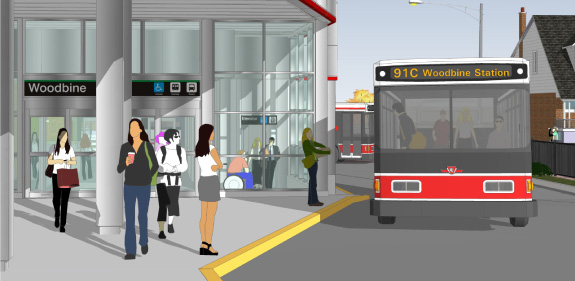Access - Spring 2016
Message from Eve Wiggins, Head of Wheel-Trans

In our last edition, I spoke about the Wheel-Trans 10 Year Transformation Strategy. I have good news to report – the TTC Board approved the strategy in its entirety at a meeting on February 25, 2016. Now the hard work begins!
First up are the upcoming changes to Wheel-Trans’ eligibility criteria. The Accessibility for Ontarians with Disabilities Act (AODA) requires the implementation of new categories for eligibility for the TTC's Wheel-Trans service by January 1, 2017. There will be three categories:
- Unconditional eligibility: a person with a disability that prevents them from using conventional transportation services
- Temporary eligibility: a person with a temporary disability that prevents them from using conventional transportation services
- Conditional eligibility: a person with a disability where environmental or physical barriers limit their ability to consistently use conventional transportation services
Customers with visual, sensory, cognitive and/or physical disabilities may be eligible for Wheel-Trans service and the eligibility could be short or long-term. Disability alone won't create eligibility; the decision will be based on the applicant's ability to use conventional transit and it will not be based on the applicant’s income or age.
We're in the process of developing new application forms and assessment tools. I’ll update you on our progress in the summer after we have presented to the TTC Board.
A large part of the transformation strategy is the movement to a Family of Services model. Under this service model, it’s possible that for customers with conditional eligibility, Wheel-Trans would only be used for part of the customer’s trip. The balance of the trip would include conventional transit services. For example, Wheel-Trans might pick a customer up at home and take them to
an accessible subway station, where the customer would board the subway and ride to the station closest to their destination.Wheel-Trans could be waiting at the destination subway station to take the customer to their appointment.
We will be conducting a Family of Services pilot late in 2016 with volunteers who are able to use more than one mode of the service. There will be more information to come on this later this year.
We're developing a robust communication and public consultation plan as we are committed to keeping you informed as we move through this process. Through the use of this newsletter and other communication vehicles, we'll let you know about public meetings or other opportunities for input.
And finally, we’re working with our regional partners in York, Peel and Durham to create better cross-boundary services for our customers. Stay tuned for more information.
As I’ve said before, we’re committed to keeping you informed every step of the way through this transformation. It's an exciting time for us and we look forward to working with all of you to create a better, more spontaneous customer journey.
Help Us Help You
We are trying to reduce wait times.
- Instead of calling us, use our automated touch-tone phone system Rideline (416-397-8000) or visit our website at mywheel-trans.ttc.ca
- If your trip is after 11 a.m. the next day, call us on that day for your trip information
407 Toronto Rehab Cardiac Centre Community Bus
The 407 Toronto Rehab Cardiac Centre Community Bus operates between Sunnybrook Hospital and the Toronto Rehab Cardiac Centre, in a generally north-south direction. Accessible service is provided on the route.
The 407 (Sunnybrook Hospital-Toronto Rehab Cardiac Centre) branch operates from approximately 8 a.m. to 9 p.m., from Monday to Thursday only.
Northbound 407 to Sunnybrook Hospital
These Community buses operate from Toronto Rehab Cardiac Centre via west on Kilgour Road, north on Bayview Avenue and into the Sunnybrook Hospital grounds.
Southbound 407 to Toronto Rehab Cardiac Centre
These Community buses operate through the Sunnybrook Hospital grounds, south on Bayview Avenue and east on Kilgour Road to the Toronto Rehab Cardiac Centre.
Community buses can be flagged at any point along the route by standing at the curb on the side of the street in which the bus is travelling and waving down the bus.
Wheel-Trans is a Scent-Free Environment
Due to the health concerns arising from exposure to scented products, Wheel-Trans has instituted a scent-free policy to provide a comfortable environment for all customers and employees.
When we talk about scents, we usually mean the smells or odors from cosmetics (perfume, make-up, shampoo, deodorant, etc.) or from other products such as air fresheners and cleaners. It's important to remember that some products that claim to be “scent-free” may have only masked the scent through the use of another chemical. People adversely affected by scented products can experience any of the following symptoms:
- Headaches
- Dizziness
- Nausea
- Fatigue
- Weakness
- Insomnia
- Malaise
- Confusion
- Loss of appetite
- Depression
- Anxiety
- Numbness
- Upper respiratory symptoms
- Shortness of breath
Allergic and asthmatic patients, as well as those with other conditions, report that certain odors, even in the smallest amounts, can trigger an attack.
Wheel-Trans customers are asked not to use scented products prior to travelling with Wheel-Trans.
Accessibility Plan Update
The TTC's Easier Access Program will make all subway stations accessible for everyone, regardless of their level of mobility. Today, 34 of 69 stations are accessible to people with disabilities. Station accessibility improvements are ongoing at Coxwell, Ossington, Woodbine, St. Clair West, Dupont, and in the planning stages for Royal York, Runnymede, St Patrick and Chester.
As part of our commitment to improving transit for persons with disabilities, the TTC is testing a new External Route Announcement (ERA) system that will indicate the route, direction, destination or next major stop as a pre-boarding announcement. The announcement will be made through a speaker located on the outside of the bus near the front door when the doors are opened.
The intent of the ERA system is help customers with vision loss know whether or not to board a bus and to help them navigate their journey on the TTC. Four buses at Wilson Garage have been equipped with the prototype. We welcome any feedback, by phone at 416-393-3030 or online through our suggestion forms.
TTC staff will continue to report back to the Board and ACAT on an annual basis on progress in implementing the goals and objectives of the Accessibility Plan, and on new initiatives.

Mind the Gap!
At Eglinton Station, there was a significant vertical and horizontal gap between the platform and the subway car. The gap posed challenges for people using mobility devices and made it exceptionally tricky to board the subway. Thanks to the efforts of Advisory Committee on Accessible Transit (ACAT) and TTC engineers, the problem has been solved.
A slight ramp was built where the gap was the largest. The ramp allows for customers using mobility devices to board the subway safely. The ramp was installed at the south end of Eglinton Station, close to the elevator. Floor decals mark the spot for easy access.
ACAT continues to work with the TTC to enable access for everyone throughout Toronto’s transit system.

The Results are in!
Our customer satisfaction survey results are in and they're terrific! Overall satisfaction with Wheel-Trans services remains very high at 85 per cent and that satisfaction is consistent across all available modes of transportation (bus, minivan, sedan taxi). An analysis of the key aspects of satisfaction highlighted that the driver, trip duration and perceived personal safety have the most significant impact on overall satisfaction.
We also learned:
- Nearly 7 in 10 customers reported a punctual pick-up and drop-off. However, the majority of those left waiting experienced delays of more than 10 minutes.
- Two-thirds of Wheel-Trans customers are familiar with the eligibility assessment process. Most customers agree that the assessment process should require a medical referral and an in-person interview.
- One third of Wheel-Trans customers use conventional transit services and half of those will transfer between multiple modes/routes.
- Customers using conventional transit would like to see greater reliability of accessibility features (elevators, escalators), but also believe that greater sensitivity and assistance from TTC operators would improve their experience.
- Satisfaction with trip booking has improved.
Customers outlined a few areas that require our attention:
- Drivers play an important role in service delivery. Customer feedback underscored the importance of driver punctuality, courtesy and helpfulness.
- Late arrivals can be better managed by more clearly communicating with customers.
- Greater marketing and promotion of the Support Person Assistance Card is needed.
Thank you to all who participated in the survey. Your input helps us to focus our attention on the areas that most need improvement.
TTC and Advisory Committee for Accessible Transit (ACAT) at People in Motion
Visit us at the People in Motion show. We'll have the newest 12-metre TTC bus on hand for customers who are new to the TTC or to the conventional system to practice boarding, securement and disembarking. We'll have an operator available to help customers and answer any questions. We will have information on the latest accessibility improvements at the TTC – what's new and what's next. Attendees can learn how to plan a trip to their destination using the conventional system or how they might combine a Wheel-Trans trip with conventional TTC service. We'll have information videos on priority seating, the new low-floor streetcar and PRESTO.
On Friday, May 27, TTC CEO Andy Byford will be on hand for an hour at 3 p.m. to chat with attendees and answer any questions you may have about the TTC.
ACAT members will also be on hand both days to answer questions about their work and gather feedback from customers on how the TTC can improve its accessible services.